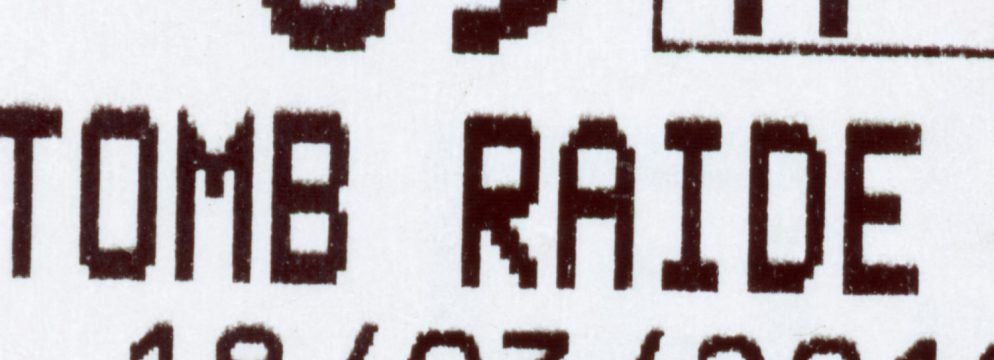Tomb Raider (2018)

No. It needed to be MORE like a video game.
I like video games. I play video games. And though that’s a Lloyd Bensen set-up, this is really about how rarely films capture what is great about video games: mechanics.
There’s a great sequence in the reboot of Tomb Raider, where Lara Croft, without weapons, has to sneak across an enemy camp. She has to get to A to B. There are six bad guys. She is unarmed. And everything takes place in a single shot. Every moment is tense, as she advances step by step, even the slightly noise or wrong move is certain death.
Sorry, that’s a bit confusing, the reboot of the video game. The reboot of the film is execrable.

The film, like all video reboots, takes the worst parts of video games – the endless cutscenes, the inability to press ‘B’ to skip the cutscene, the implied knowledge that people who think that cutscenes are a good idea exist, and puzzles (I’m here to shoot stuff). It leaves out anything that could be of the slightest interest. This criticism could be levied at almost any film. I’m looking at you, Romantic Comedy.
The video game.
There are currently six films in the hopper that have the exact same problem – zero grasp of story mechanics – so I’ll keep it short.
Short for me. For me.

Not my first time at the lovely Gaumont Champs-Elysées, which holds films much longer than the Opéra. They have ornate plastic chairs. You’re just going to have to click the link. Which means you’re just going to have to learn how to find the link.
Two examples, both with good and bad parts. Rather, both with me attributing undeserved good parts. Because I always see the best. I see everything. That’s the title of the blog now. Omniscience, because God is blog spelled backwards.
I’m God now; I can spell things how I like.
The beginning, even though it introduces this idea twice, is better than the video game: Fr. Vikander is broke. Her having endless money is appropriate for the fantasy of the video game, but it’s not a good movie beat. Without her inheritance, there is somewhere to go, some conflicts to be resolved, some…
Oh, I see. She just has to sign a paper. The conflict is clear now. She didn’t want to. We can all relate to that.
The film descends into further bafflement, when, having signed the papers (apparently, its grumpy daughters that declare someone’s death, not the state or the coroner. We’ll just add this to my fake expertise of UK law, like the high murder and high children getting kidnapped rate of English villages no bigger than 145 inhabitants. This is why London is so safe), she still doesn’t have the money. She only gets the money at the end, when…she gets it I guess. There was probably another piece of paper she didn’t want to sign.
It would be tempting to criticize the film here, and I am, but it’s just typing – people who don’t have the slightest idea of how one scene might relate to another. As in: I think she should be broke here! Yeah! That’s a scene! And then she’ll have money! Hey, I think that’s also scene!
We’re writers!
Fortunately for my faith in humanity (lack of faith is a kind of faith. Remember, I’m God), the level of directing is at exactly the same level. I’ve briefly talked about Shigeru Miyamoto-tono, and my desire to copy the third person POV shot for action.
In brief, I play video games, my friends don’t, but spend a lot of time watching me, and I think that’s why. Few films – save Mr. Spielberg and Sr. Cuarón and Mr. Cameron and Mr. Hitchcock – appreciate how potentially exciting it might be to see things from the point of view of the character as they navigate obstacles.
This is crucial idea – that we don’t need, hopefully at this point, the close up to relate to the character. If the film is working, we are the character, even if that character is, you know, dumping the body of Ms. Janet Leigh in a swamp.
What Tomb Raider offers instead is a kind of object lesson. We do see this shot, and when we see her jumping over one of those canyon gaps that don’t exist from her point of view it’s exciting. For about 18 frames.
See, according to a certain Herr Roar Uthaug (how can someone named Roar Uthaug make a bad film??????) we need, in addition, close-ups, CGI overheads traveling through rust holes to far overhead and then back again through a mirror reflection of a falling drop of water, and – most arcanely – 1950s side-tracking shots, which has exactly the intended effect: that we’re watching the gang in Scooby-Doo walk through an environment over and over again. Goldbusters this ain’t.
Person who saw Goldbuster you ain’t, but I’ll get to it eventually. In HTML, Goldbusters will change to Goldbusters. Hasn’t changed yet. You’ll have to come back.
I was reminded of the worst parts of Dunkirk, that they had taken the trouble to shoot some sequences from this angle, but didn’t have the intelligence to risk staying with, to know how much tension holding a shot can have. This is not the only way to put us in the character’s skin, as even Sr. Cuarón seems to know, but whatever way there isn’t they seem to find it.
Hey! That’s another shot!
I’m a director!
The Take

-$2.25
The Lonely Comments Section

 [logo]
[logo]